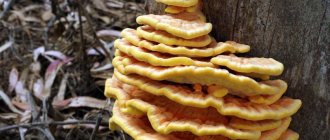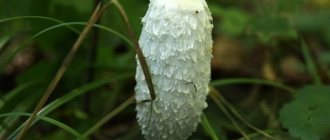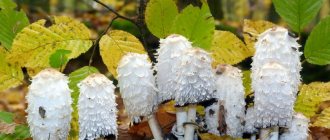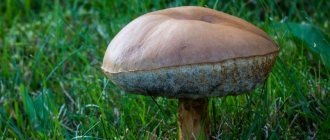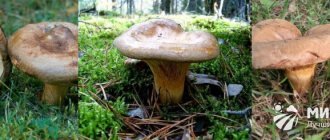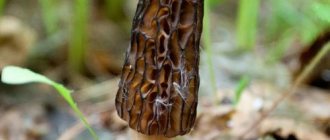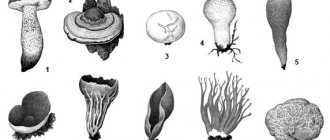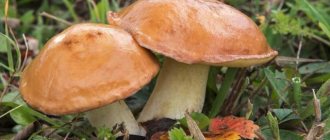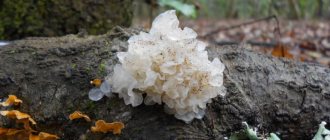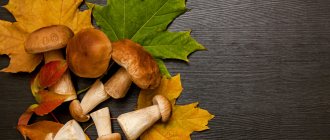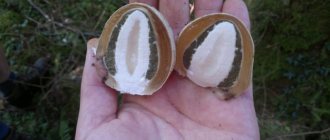Systematics, characteristics and description of the structure of the parasitic fungus
The true tinder fungus is sometimes also called the blood sponge; it bears the Latin name Fomes fomentarius; there are also synonyms: Polyporus fomentarius, Boletus fomentarius, Ungulina fomentaria, Fomes griseus. Belongs to the genus Phomes of the Polyporaceae family.
Mushrooms are sessile, without stalk. The cap of young specimens is rounded, then becomes like a hoof. It is attached to the tree by the center of the upper part.
The mushroom is perennial, reaches a diameter of 40 cm, and can be up to 20 cm in height. The surface is matte, stepped, with ridges. Sometimes covered with small cracks.
The color ranges from light gray to dark, with occasional beige shades.
The hymenophore, the lower part of the cap, consists of tubes, the pores of which are quite large and light-colored. They darken when pressed. The spores are white.
The pulp is very dense, hard, cork-like, often woody. The cut is usually velvety and does not change color. The color is brown or reddish-brown.
A little history
The first mention of this mushroom belongs to the Swedish scientist, naturalist and physician, Carl Linnaeus. He described the tinder fungus at the beginning of the 18th century, but in 1849, compatriot Elias Magnus Fries changed the generic affiliation of this species.
Big city problem
Modern people have little faith in such legends.
Scientists are also breaking myths. Zoologists have found that the legs of this bird are very short, and it is this length that helps to maintain balance. In addition, all tiny winged birds move by jumping. The researchers first added the prefix “pet” to their name. Indeed, now these birds live very close to human habitation. The birds' homeland was Northern Europe, but over centuries of evolution they settled throughout the globe.
Today it is increasingly difficult for them to survive in large cities. More often, parents think about what to feed the sparrow chick. There are few insects in large populated areas, so dad and mom add bread and seeds to the child’s diet, which they don’t really like.
Sometimes chicks fall out of their nests. To understand how to save a baby sparrow, you need to determine the cause. If you find a baby on the ground, look around.
If a sparrow chick falls out of the nest by accident, return it back. Sometimes babies instinctively reach for their parents when falling from trees. If everything is in order with the “bird house”, the parents are there, then tragedy will not happen.
Natural disasters can also destroy a nest: a hurricane, a thunderstorm. In this case, you can help the birds by restoring their home. Return the kids to the renovated house and watch them. If the parents respond to the cubs' call, the rescue mission is over. If this does not happen, you will have to feed the young animals.
Sparrow chicks grow up to independent age of 2-3 weeks. That's how long it takes for the cubs to hatch.
Life cycle, time and place of fruiting in nature
The mushroom is a forest health worker, most often found on dead wood, distributed throughout Russia and Europe, prefers deciduous trees.
It can affect weakened plants, infection occurs through cracks, broken branches and damage to the bark. The tinder fungus is a saprophyte and causes white rot.
Because of it, the tree trunk becomes fragile and brittle. The most favorite species are aspen, oak, alder, birch and beech, but it is also found on others.
Frontignac
Up to -34°C, which makes it possible to grow it without cover. Frontignac is a red wine grape variety, released in 1996. Medium ripening period, in the Kiev region it ripens in early September. The bushes are vigorous and begin to bear fruit early. The clusters are medium, medium dense. The berries are black, small, round. The clusters can hang on the bushes for a long time, accumulates sugar well up to 24-26%, but the acidity is also high. Even in wet years, damage to berries by gray rot and cracking was practically not observed. The yield is plentiful; sometimes crop rationing is required.
Down to -34°C, a gray-berry variety of Frontignac from which white wines are made. The vine has essentially the same characteristics as Frontignac. However, the wine is very different, with aromas of peach, apricot, pineapple and citrus on the palate without a grassy or labrusque aftertaste. This variety has not been tested at the Geneva Experimental Station.
Growing at home and in the country
Polypore is grown quite rarely, mainly for medicinal purposes. To do this, you will need to purchase fungal mycelium and prepare pieces of wood at least 50 cm long and 25 cm in diameter. You can also use a dead tree or stump.
In order to introduce mycelium, you will need to drill holes or saw bars, then populate the spores and seal with adhesive tape.
The top should be covered with straw or burlap. The mycelium will overgrow after 10 months if the temperature is within +7+27 0C.
Reference! Breeding should take place in the coolest and most shaded corner of the garden, and the fruits can be collected for medicine for 5 years in spring or autumn.
Kishmish Catawba
Up to -29 °C - and tastier than Spartan, but not as frost-resistant. Similar to raisins Jupiter and Venus. Can be grown as an uncovered plant on arches, arbors, etc.
Down to -29°C, you need to be prepared for the fact that once every 6-7 years it will completely freeze to the level of snow. At the same time, next year Jupiter will quickly “beat off” new shoots from dormant buds and it will be possible to get a small harvest. We will test for lower temperatures if Mother Nature allows. Seedless variety, early ripening (115-125 days). The bushes are medium-sized. The clusters weigh 1 kg on average. The berries are large, weighing 4-5 grams, and color from red to blue-red when fully ripe. The pulp is fleshy and juicy, good taste with a slight nutmeg aroma. The skin is thin and durable. Sugar accumulation up to 21%. There may be freezing and death of the buds in frosty winters and spring frosts, fluctuating temperatures (plus during the day - below zero at night).
Up to -28°C and below, recommended for uncovered crops (arches, arbors, etc.). Brown (1977) variety, early ripening, 120 days). Bushes have above average growth vigor. The clusters are medium, from 200 g and above, cylindrical-conical, of medium density. The berries are small and medium 2-3 grams, round, blue. The pulp is fleshy and juicy, the taste is harmonious, with a light strawberry-nutmeg and blackcurrant aroma. The skin is not thick, separated by a “bag”. Seedlessness class I. Sugar content 18-20%, acidity 6-7%.
Down to -32°C, which makes it possible to grow it as a semi-covered or uncovered, seedless grape variety. Selection: USA. Late ripening (late September-early October), isabella type. The growth vigor of the bushes is medium to large. The flower is bisexual. The bunch is medium and large, wide, conical or almost cylindrical, with one, rarely two, wings, rather loose or dense. The berry is medium, round or oval, purple-red, dull, with a pronounced nutmeg. Sugar content 25%, acidity 8.8 g/l. The ripening of shoots is average. Productivity is average.
Up to -34°C, early ripening (115-125 days). Self-rooted bushes are vigorous. The clusters are medium-sized and large. The berries are round, yellow-green, with an average weight of 3-4 g. Seedless category I, rudiments are either absent or very small, practically not felt when eating. Increased resistance to fungal diseases and frost. Harmonious taste with strawberry flavor. Bunches 800-1200 g.
Edibility, medicinal properties, beneficial properties and contraindications
This mushroom was called a blood sponge for its ability to stop blood. It contains so many beneficial elements that it is suitable for the treatment of most common diseases.
And most importantly, polypore has the ability to stop the development of cancer cells, so it is often used to prevent this particular disease.
The true tinder fungus is inedible. Sometimes an allergic reaction occurs to mushrooms, in which case it is prohibited to use them as medicine.
In addition, in ancient times, tinder was used to make many useful things in everyday life, and was also used to produce tinder, which can easily ignite, repel unwanted insects and maintain a smoldering fire.
How to distinguish a real tinder fungus from false species
This type of tinder fungus is difficult to confuse with other representatives of the Mushroom kingdom. But inexperienced mushroom pickers can make mistakes, so you need to know how to distinguish between a real tinder fungus and other similar fruiting bodies.
- Chaga. The birch sponge has no special similarities with tinder fungi. Only a person who has never seen either mushroom before can confuse them. Chaga is ash-colored, even black. It also has an irregular shape and is inedible. However, this parasitic fungus primarily affects birch trees, while tinder fungi can grow on different trees. To distinguish the fruiting bodies, just look at their appearance: chaga is completely black, and tinder fungus is gray.
- Larch polypore. This mushroom has been known for a long time and is considered very valuable. And there are many similarities between it and the real tinder fungus. So, the larch tinder fungus is called that because it grows on larches, as well as on pine cedar. And this fruit mainly affects living trees. Distribution areas also differ. Since larch grows most often in Eastern Siberia, the larch species of tinder fungus can be found there. Less commonly, they are found in the Urals or in the northeastern part of European Russia.
False tinder fungi are not dangerous, but they do not have the same composition as the blood sponge. It is very easy to distinguish between such varieties, but to do this you need to be careful.
Chemical composition and economic importance
The true polypore contains a large amount of proteins and carbohydrates, it has a lot of fiber and resinous substances, and it is also famous for its content of B vitamins, manganese, potassium, selenium, phosphorus and zinc.
Due to the high rigidity of the fruiting bodies, various household utensils were often made from tinder fungi. Its porous part was used for sharpening knives, and its suede surface was used for making clothing, such as slippers, hats and hand muffs.
A large number of crafts and souvenirs made from tinder fungus were popular. Unprocessed mushrooms produce unique interior items that are sold in stores to this day.
Popular varieties
The most popular varieties:
- Larch (real). These mushrooms are characterized by a prostrate fruiting body (20-30 cm long), painted in a dirty white shade. In young plants the flesh is soft and elastic, in mature plants it is hard and crumbly.
Larch polypore is not edible, but is used for medicinal purposes to prepare infusions, decoctions and powders aimed at removing toxins and carcinogens from the body, destroying pathogenic flora of the liver, lungs, bile ducts, accelerating metabolism (for weight loss). Most often it grows on dead wood and fallen trees.
- Flat (sulfur yellow). A characteristic feature of the mushroom is its voluminous dark-golden cap (20-30 cm in diameter), visually reminiscent of polyurethane foam. On the surface of the fruiting body there are often uneven ridges covered with a dense matte peel.
The sulfur-yellow polypore is edible only at an early age, since the caps of overripe plants are excessively hard. In addition to the food industry, the mushroom is used in pharmacology for the production of drugs aimed at combating rheumatic tuberculosis, esophageal cancer, impotence, stomach ulcers, diabetes mellitus, and liver diseases.
- Lacquered (reishi). A distinctive feature of the mushroom is a shiny, vermilion-like cap set on a lateral voluminous stalk. At the same time, the color of its fruiting body can vary from bright orange to dark red.
The lacquered polypore is used exclusively for medicinal purposes, since the mushroom is inedible. This is a powerful immunomodulator with pronounced antioxidant properties. It is believed that the mushroom is able to suppress the growth of cancer cells and is useful for people suffering from arthritis, rheumatism, asthma, and respiratory diseases.
Research into reishi on the possibility of its use for medicinal purposes continues to this day.
- Umbrella. The rarest species of tinder fungus, listed in the Red Book. The fruiting body of the mushroom consists of many small brown caps bordered by multi-colored wavy stripes. The culture grows in places with high humidity, especially at the base of stumps and trunks of beech, maple, birch, and hornbeam.
The umbrella tinder fungus is classified as an edible mushroom.
- Birch. A mushroom with spherical fruiting bodies, light flesh and smooth gray-white skin. This parasite grows exclusively on birch tree trunks. On its basis, medicines and biologically active complexes are created aimed at restoring intestinal function (eliminating constipation), increasing the body’s immune response, and calming the nervous system. The mushroom weakens appetite, has strong diuretic properties, due to which it is used for weight loss.
At an early age, birch tinder fungus can be used as food.
In addition to their medicinal and nutritional value, mushrooms are an important component of the cycle of substances in nature. Polypores, decomposing organic compounds into mineral ones, have a positive effect on the soil biocenosis.
Use in folk medicine
In folk medicine, internal spongy tissue is used to prepare infusions, it is dried or decoctions are prepared.
The most common use of a blood sponge is to stop bleeding by applying it externally to a wound. It has a bactericidal effect.
It also helps with painful menstrual bleeding and in the treatment of hemorrhoids, and in the 19th century its hemostatic properties were used by dentists and surgeons.
The resins contained in the body of the mushroom help cope with viruses and bacterial infections. They are able to overcome pathogenic bacteria of the biliary and pulmonary tracts, liver, and can cope with pneumonia, tuberculosis, hepatitis (for this they use a decoction of powder).
It’s easy to prepare; just boil 1 tsp in 200 ml of water. tinder powder for 20 minutes. A lotion made from this composition will help with bruises. And if you drink a decoction of 1 tbsp. l. three times a day before meals for 3 months, it can reduce blood sugar in a diabetic.
A tincture of tinder fungus is prepared using vodka or natural Cahors. To prepare, mix 50 g of mushroom powder and 0.5 liters of alcoholic drink. Seal and leave for 15 days in a cool place. You should drink 10 ml per day for 3 months. This drink is an excellent remedy for cancer prevention.
Important! Mushroom preparations are prohibited for use by children under 12 years of age, as well as by pregnant and lactating women.
Reproduction
Potato propagation can be done in two ways - vegetative and sexual.
The vegetative method of propagation is growing potatoes from tubers. This method also includes propagation using segments of stems, which must have one apical or several lateral vegetative buds.
The most common method is to grow potatoes from tubers. And stem cuttings are planted in cases where the number of tubers is limited, and some new valuable variety requires quick introduction into practice.
Its most important parts are the stamens and pistils. Complex processes associated with sexual reproduction occur in them.
In flowering plants, male gametes (sperm) are very small, while female gametes (eggs) are much larger.
Each pollen grain of angiosperms consists of vegetative and generative cells. The pollen grain is covered with two coats. The outer shell, as a rule, is uneven, with spines, warts, and mesh-like outgrowths. This helps the pollen grains to stay on the stigma. The pollen of a plant, ripening in the anthers, consists of many pollen grains by the time the flower blooms.
Collection and procurement rules
You can collect tinder fungi throughout the year, but only those bodies that grow on still living trees should be used for medicinal purposes. It is better to use young specimens that have not had time to absorb heavy metals. It is easy to cut off a real tinder fungus; you can simply press on the top part.
You need to harvest it after it dries, but the mushroom becomes hard almost immediately, and therefore you should remove the rough upper part, otherwise it will be quite difficult to do this after complete drying.

